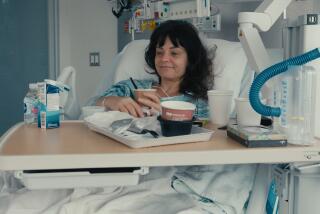When Giving Becomes a Life or Death Decision : Health: John Del Gatto is trying to teach the value of organ donations after the agony of his daughter’s death turned into the joy of saving four others.
- Share via
In death, Monique Del Gatto managed to give life.
When she was admitted to Cedars-Sinai Medical Center in Los Angeles with massive head injuries after being hit by a car in March, 1990, tests performed on the 23-year-old aspiring actress and model exhibited no brain activity. A respirator kept her alive, but doctors said there was no hope of recovery.
After nearly four days of agonizing deliberations, family members agreed to take her off the respirator and donate her heart, liver and kidneys to four gravely ill patients awaiting transplant organs.
That difficult decision was only possible after the family learned, through a chance conversation with one of her girlfriends, that Monique had expressed a desire to be a donor should such a situation arise.
Surely there must be a better way, thought Monique’s father, John Del Gatto, a 45-year-old Manhattan Beach real estate broker.
“No one should ever have to go through what I went through . . . trying to figure out what my daughter wanted to do,” he said.
Three months later, Del Gatto founded Motrain Inc., a nonprofit organization in Manhattan Beach that operates on private contributions and federal grants, and seeks to educate Americans about organ donations and the need for families to discuss them.
“I learned that . . . about 10 (years ago) . . . they came up with the Anatomical Gift Act, which says the hospital, the surgeon, has the authority to recover one’s organs based on the evidence of a signed donor card” like the ones California drivers can sign and carry with their driver’s licenses, said Del Gatto.
“I also learned that . . . the only way that (the medical community) will recover organs is through a consent document signed by the next of kin . . . (even though) over 90% of Americans believe that when they sign a donor card they’ve done all they need to do to become a donor.”
Jayne Miller, administrative director of the Transplantation Institute at Loma Linda University Medical Center, agreed that the donor card “hasn’t been the answer that everyone thought it would be.”
Although the donor card provides a legal authorization to recover organs, Miller said the medical community considers it morally unethical to proceed without the family’s consent.
She added that other factors have conspired to further decrease the pool of organ donations.
“Communicable diseases are at the highest rate ever in the history of mankind. The use of drugs . . . and the AIDS population rules out many donors. For the second straight year in a row, traumatic (vehicular) deaths in our state and nationwide are down substantially. That’s good news for us as Americans, and as Californians, but it has been a woeful reality for those waiting for organ transplantation.”
As a result, thousands die each year while waiting for organs to become available, said Joel Newman, spokesman for the United Network for Organ Sharing, a national clearinghouse for organ donor and transplant patient information in Richmond, Va. In 1991, the most recent year for which statistics are available, more than 16,000 transplants were performed, but nearly 40,000 patients were on waiting lists.
Many are like Gina Ramos, who received Monique’s liver within hours of the Del Gatto family’s decision. A sudden bout of toxic hepatitis had put the 8-year-old Lincoln Heights girl into a coma, with death potentially hours away, according to her mother, Gloria Ramos. Three weeks later she was able to resume normal activities; today she is a healthy fifth-grader.
Or Katherine Lawrence, a 32-year-old Northern California banker who received a kidney from Monique. Though not immediately life-threatening, her condition required self-administered dialysis four times a day, and for 19 months she was forced to watch the increasing toll from her deteriorating kidneys while she waited for a donor organ.
“I couldn’t go up a flight of stairs without being totally winded. I couldn’t walk down the street without having to sit and rest along the way. I had chest pains . . . my heart was enlarged. My blood pressure was high, and I had what’s called a galloping heartbeat, like 135 beats a minute. The poison in my body (from kidney failure) would have eventually caused breakdowns in other areas.
“Afterward I was ecstatic,” added Lawrence, who lives in Danville, Calif. “The difference in the quality of life is so phenomenal. I still feel like I could conquer the world.”
A second kidney went to an Orange County woman, and Monique’s heart, to an anonymous recipient in Los Angeles. Both remain alive.
Del Gatto takes every opportunity to expound on these success stories and the need for more organ donors. Toward that end, Motrain recently completed a pilot educational program at Mira Costa and Redondo Union high schools, using teen-age peer counselors to present information about organ donation to 900 fellow students.
A take-home brochure and fill-in letter was given to each student, enabling them to communicate their wishes to parents or a family friend. The group is working on production of a nine-minute video they hope will allow schools and other groups to more easily disseminate the material.
“I learned that the key thing is family discussion,” Del Gatto emphasized. “Your family is going to make the decision, not you. You want your wishes to be followed . . . (but) you don’t talk very well when you’re dead. That (family member) is speaking for you--it’s important that they know.”
Lawrence echoed these sentiments as she described the late-night telephone call, the operation that changed her life and the dramatic events she now knows to have preceded them.
“They very nearly didn’t donate Monique’s organs,” she said. “It came close to not happening.”






